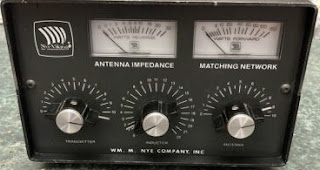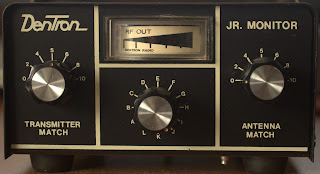Review of the AV-18VS is after the images.
I've never been active with this blog, and keeping to that tradition, it's been over 3 years since my last post.
Since the last post we moved from Florida to Michigan. We chose a quick to purchase and occupy house that would be handicap accessible and we could pay it rather than mortgage one.
Our plans were to casually search for a house that fit our needs, and be in it in about 3 to 4 years or sooner. Covid-19 put those plans on hold.
2020 was going to be our year. We will wait.
Because of where we live I am restricted to what antenna I can install.
I worked Field Day 2018 from my home station with a multiband mobile antenna mounted on the rain gutter and grounded the down spout.
That arrangement at least got me on the air.
2019 Field Day I installed a random wire. Bands were dead. I planned to work QRP. I did not do Filed Day 2019.
Field Day 2020. Goal was all week end QRP on batteries.
I wanted to work 80 meters over night this year so I bought a
Hy-Gain AV-80VS. Not much of an antenna and only about 1/16 wavelength on 80. I like messing with short verticals. This antenna is also quite stealthy compared to the
AP8A and many other 24 foot and taller verticals.
Not all that much to get a Hy-Gain AV-18VS put together and mounted on a metal pipe driven into the ground. The coil is the problem. See photos.
Out of curiosity I tried the antenna without radials. As expected VSWR of 3:1 or greater on every band.
Clipped 4, 67 foot long radials onto the antenna base and laid them out in the yard. Surprisingly most of 80 meters was 2.5 and under with a 1.3:1 dip at 3.25MHz to 3.60MHz. Suits me. The old Novice section of the band, and my CW is not all that good. If I do any CW I'll be fine. The band from 3.60 to 3.75 was about 1.4 and 1.5:1.
I tweaked the antenna by moving the coil tap around and was able to move the VSWR dip a bit higher on the band. I now had a 1.2:1 dip at 3.62MHz, and a useable 1.4:1 on the Novice frequencies. I did not measure grater than 1.5 until 3.87Mhz and VSWR was still only 1.7:1 at 3.90MHz. Plenty for what I expected to do on 80 for Field Day.
 |
| Sorry for the bit of blur. The first thing about the Hy-Gain AV-18VS is the cheap quality. I can live with the tubing, but the coil could be better built. As it is if even the correctly sized clip were shipped with the antenna I'd be ok, but the clip is for size 14 wire and the coil is made of 16 or 18 gauge. Time to order the correct, and much better quality, clips from DXE. Both clips are screwed together tightly as possible. DXE on left, Hy-GAin on right. |
 |
| This is how the clip is properly attached. No shorting adjacent turns, and fits tight to the turn to which it is clipped. |
 |
| Good Quality DXE clip on the left. Poorly fitting MFJ clip on the right. MFJ owns Hy-Gain. I am familiar with some pre-MFJ Hy-Gain antennas when the tubing was heavier and better quality parts were used. |
 |
| Clip supplied with the antenna does not fit tightly no matter how hard the screw is tightened. It is also difficult to not short to an adjacent or both adjacent turns. Compensation for shorting adjacent turns can be done by relocating the clip to a point where the antenna is resonant or low VSWR, but the clip must be able to be fastened tightly to work reliably. The tip of the clip is not what is tightened to the coil. It is the part formed for the wire, and it is tightened as tight as possible. It is loose enough it will fit the turn as seen. |
 |
| DXE on the Left, HyGain on the right. Notice the supplied clip shorts to both adjacent turns. |
On a different subject:
 |
| The AP8A top section got damaged by the movers. I bought a new tube from DXE, and some of the DXE Guy Line Caps. I have not installed The AP8A, nor did I plan to use it on Field Day if the Hy-Gain worked. The Hy-Gain arrived a few days before Field Day. I had time to check it out. |
 |
| DXE has much better quality tubing than even the original pre-MFJ Cushcraft tubing. New top section DXE tubing is inside the next to the top section on the left. The original AP8A top tube is on the right. 0.03" wall compared to 0.05" wall of the DXE. |
Back to the AV-18VS coil. I worked with thousands of tapped inductors made from wire and flat edge wound on commercial A.M. transmitters, antenna base coupling units, and phasors. So the el-cheapo Hy-Gain in a way was no surprise considering it is made for ham radio and by whom it is made. Seems hams over pay for low quality equipment in many ways. This coil could be made of heavier wire, spaced nicer, and the clip correctly sized for what the antenna costs. As it stands this antenna should cost about $75.00, and perhaps even include shipping.
The tubing walls are thinner than that of my Cushcraft or Mosley verticals. OK, they are taller so they need heavier walled tubing. Still if the AV-18VS is permanently installed it must withstand wind and depending on location, ice.
The entire base could be better designed to house the coil, and several correct clips could be included with the antenna for easier band changing.
Alternatively the coil could be made like some of the old mobiles with plug in taps to jumper to the correct band.
Finally the base quality is very poor quality. I worked with first day apprentice machinists that knew enough to break burrs, sharp edges, and smooth all rough edges on stamped metal parts. None of that was done to this base.
First thing I did when I unboxed the antenna was see the unfinished base. I got one of my smooth files and removed all of the sharp edges and burrs from the base. Next step was to clean all the holes with a de-burring tool. Then I was ready to assemble the base. Everyone who does this should charge MFJ to complete the work their shop should be doing. I'm sure if we all charged them $50.00 to de-burr their bases they may ship quality product.
Assembly was simple and straight forward.
Finding the correct tap was easy. Locations are approximated in the instructions and I found them not to be far off.
I did shorten the jumper lead and installed a DXE clip. There is no need for the jumper to be as long as what is supplied. Half as long is more than sufficient.
I only set the antenna for 80 meters. Results were ok. I did not work as long into the night as I planned. Took a nap and resumed again about 0300 EDT Sunday.
Changes I plan for the AV-18VS is test is without the loading coil with my AH-2 which should match the antenna quite good on all bands to 40 meters. I may need to add a top hat for 80 meters.
I also plan to place clips on the antenna coil as presently built. I can use short clip leads to clip to the 80M tap and to which ever other band I choose. The idea is to be able to field deploy this antenna for portable operation.
Meuller #45 clips work quite good for clipping the radials to the base and having a few short jumpers with one on each end can be used on the coil taps. Rather than moving a clip, let the coil tap clip attached and use clip leads.
When the weather gets a bit cooler I'll do all the bands as well as add an SO-239 to the base. The base is already punched for one (Thanks MFJ/Hy-Gain).
The challenge is to neatly fish the coax through the base tube and out to the coil and base. Could be as simple as a grommeted hole for RG-8X or an enclosure for the coil too.
Would I recommend the Hy-Gain AV-18VS? Sure. Considering the cost of other antennas this one is ok if you don't mind manually changing bands. There are ways to work around that. Those ways will need a post of their own.
Is the AV-18VS worth the price? Well, those who know me know I'll say no because I think all amateur radio antennas except a few are way over priced. So much so I have yet to purchase a new one except for the AV-18VS because it is perhaps the cheapest vertical on the market. Cheapest price-wise, and the cheapest quality-wise I've seen.
Now speaking as strictly a ham radio operator. I know what is out there. For the price you won't find another antenna this nice. Put it together and put some radials on it and you have an antenna that will cover from 10 meters to 80 meters. No other antenna for $150.00 will do that.
The AV-18VS can be ground mounted, pole mounted with a counterpoise, or roof mounted with a counterpoise or tuned radials.
The AV-18VS is small enough to be easily raised and lowered in an antenna restricted location. It may even be small enough to be left up ground mounted in the bushes or even the yard or on beside the deck, and there are probably other places. As long as a few radials can be laid the antenna should work.
This is the kind of antenna one can experiment with. Build your own coil and test it. Add a top hat. Instead of a top hat try adding a wire. Instead of radials, a counterpoise or a ground plane.
Beware though if you buy one (and maybe other Hy-Gain, Hustler, or Cushcraft antennas) be prepared to de-bur the base.























